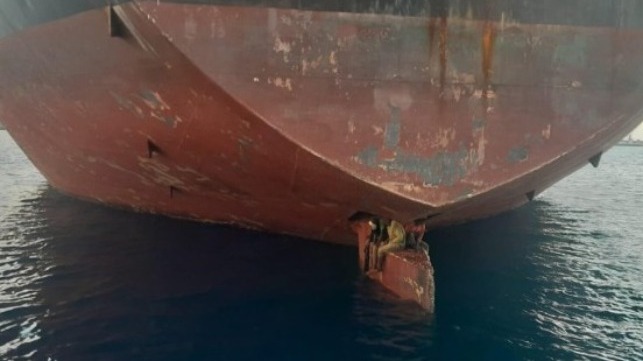Op-Ed: Befriending Stowaways Puts Seafarers at Risk

As the container barge Brooklyn Bridge arrived in San Juan on a routine voyage from Jacksonville last week, 16 migrants jumped over the side and attempted to swim to shore. They were in possession of life jackets, and they were rescued from the water by a patrol boat from U.S. Coast Guard Sector San Juan. This is just another recent example of stowaway activity, and unfortunately not all incidents are safely resolved.
Stowaways often have tragic stories to tell about their past and what has led them to take the risk of illegally boarding a vessel. However, their desperate circumstances can lead to unpredictable actions, and seafarers should beware. The best thing for the Master to do is notify the office immediately on discovering stowaways and for crews to resist befriending them.
Otherwise, stowaways can create safety issues and legal problems for crews. A case study involving seven male stowaways found aboard a bulk carrier after it had left Kenya should serve as a warning to all shipping companies and their crewmembers. The stowaways were treated in accordance with IMO guidelines, but the situation became problematic once they struck up friendships with the seafarers. The mariners agreed to help them disembark the vessel at another port, while the Master failed to report to the shipowner that he had stowaways on board.
On learning that their final destination was in South America, the stowaways planned to leave the ship in Durban and board another vessel heading elsewhere. In Durban, the crew gave the stowaways clothes and money, before rigging a rope on the seaward side of the vessel to enable the illegal passengers to enter the water without being spotted from ashore.
The seven stowaways planned to swim to the opposite side of the shore, but two tragically drowned as they were not strong swimmers. The remaining men reached safety and handed themselves into the authorities. They then accused the crew of forcing them off the vessel and into the harbor, leading to the arrests of the ship’s Master and three crewmembers who were all charged with murder.
The local authorities rightly took the claims seriously, as this type of crime is not without precedent. An American tugboat captain forced three Jamaican stowaways to jump into shark-infested waters after finding them on his ship in 1993. The stowaways were never found.
In the current case, though, the accusations was unfounded, and the charges the crewmembers faced were later reduced to manslaughter after it became clear the stowaways had embellished their story. However, the Master and three seafarers had clearly breached immigration law. They were eventually found guilty of assisting the stowaways and smuggling them ashore, which saw them receive suspended prison sentences and fines.
In another case, UK special forces stormed a tanker after reports of a stowaway hijacking. Charges against the stowaways were ultimately dropped due to lack of evidence that the crew were threatened or that the stowaways intended to take control of the ship. The situation was, however, tense, and therefore dangerous.
So, while friendly conversation with stowaways may seem normal and harmless, seafarers can easily fall into the trap of making bad judgement calls that leave them in danger or open to prosecution.
Crewmembers who allow men or women they have befriended in foreign ports to stow away on board may also face prosecution. Violating immigration laws is one risk; another is that the stowaways accuse seafarers of impropriety or more serious offenses if caught by the authorities.
Around 1,000 stowaways are discovered each year. Cape Town, Durban and Lagos are boarding hotspots, with Bilbao in Spain popular with stowaways trying to reach the UK.
Advice for dealing with stowaways is available from the IMO’s Resolution A.871(20) Guidelines on the Allocation of Responsibilities to Seek the Successful Resolution of Stowaway Cases. Additional guidance on how to treat stowaways can be found in Section 4C of the Facilitation of International Maritime Traffic Convention. However, neither cover the risks of befriending stowaways.
Our general advice to members is to follow the IMO guidelines and instruct crewmembers to refrain from socializing with stowaways or granting them special favors. Additionally, the Master should notify the office immediately and provide as many details as possible if a stowaway is discovered onboard. Those details should then be forwarded to the company’s insurer at the first opportunity to expedite the repatriation process. This could involve returning to the stowaway’s country of origin, if this can be determined, or to proceed to a scheduled destination port. Either way, it is likely to be costly for the shipowner. Best not to add to those costs by putting crew and stowaways at further risk through misguided friendships.
Useful resources for additional information on stowaways include the Nautical Institute’s ‘Stowaways by Sea and Rescue of Migrants’. West P&I members can also get in contact with the club should they have any follow-up questions on stowaway incidents.
Simon Hodgkinson is Head of Loss Prevention at West P&I.
The opinions expressed herein are the author's and not necessarily those of The Maritime Executive.
